Are you thinking about your or the other parent’s parenting styles and wondering what effects they have on your kids? You might also be thinking about a change in parenting styles and if it’s even possible, too. And to what extent is your parenting style affected by your own experience with it. And what to do about it all.

What The 5 Parenting Styles Are
You might also be worried because you spotted your and your (ex) partner’s parenting styles clash. So you’re not sure how to address it or how much attention to pay to it.
If you answered yes to some of these questions, then stay with me to explore this topic now!
WHAT ARE THE 5 PARENTING STYLES?
The 5 parenting styles are:
- Authoritative (democratic or balanced parenting style,
- Authoritarian parenting style,
- Permissive parenting style,
- Rejecting parenting style, and
- Uninvolved parenting style.
This post will tell you what each parenting styles look like, and how they’ve evolved. As well as what’s the best or optimal parenting style.
But that’s not all. It’ll also address what influences the parenting styles and whether they can change. As well as what happens when parenting styles clash, and whether should you argue in front of the kids.
And at the end, as a bonus, you’ll find tips if you realize you’d like to or need to adapt your parenting style.
So without further delay, let’s jump to all the important things about parenting styles!
Note: Although I am a Clinical Social Worker, engaging with this website does not establish a professional social worker-client relationship. The information provided here is for general purposes only and should not be considered professional advice. While we strive to ensure accuracy and reliability, this content is not a substitute for professional guidance. For specific concerns, issues, or situations, it is essential to consult a qualified professional and present your situation. Read the full Disclaimer here.
Before I described them, let’s see what a parenting style means and who discovered parenting styles. If you already know this, go ahead and jump to the styles directly. You can use the table of contents.
WHAT DOES PARENTING STYLE MEAN?
Parenting style refers to the consistent and stable patterns of demands, structure, and responsiveness that parents cultivate in all of their interpersonal interactions with their children. The parents’ practices are dependent on these patterns. That’s why it’s called style – it is perpetual and it’s resistant to events, situations, a child’s age, and developmental phase. This doesn’t mean that it’s unchangeable, it only means that it is constant.
WHO DISCOVERED PARENTING STYLES?
The deceased Diana Baumrind, a developmental psychologist with a Ph.D. in psychology discovered parenting styles. She is recognized internationally as a pioneer of research on parenting styles.
Today we can thank her we now know what is effective parenting and how to be effective parents!
Diana Baumrind is well-known for her groundbreaking research on prototypes of parenting styles, well known as ”Baumrind’s parenting typology”. But she is also well known for her ethical and principle approach to research practices.
Her results regarding parenting styles investigation have influenced and have been replicated in hundreds of studies and her findings are authenticated.
Baumrind, of course, didn’t stop there. Moreover, throughout her career, she continued researching and engaging in parenting theory development. She continued doing it even when she was already + 80 years of age! How inspiring!
More interesting facts about the amazing Diana Baumrind, I encourage you to read, you can find them in the In memoriam section of the University of California.
Don’t have enough time but really want to dig into the 5 parenting styles and find yours? This is pretty long blog post so if you’d like to take it with you, get it as a print-friendly pdf with no interruptions on page.

What the 5 parenting styles are: all you wanted to know
5,99 $ 4,99 $
HOW DID DIANA BAUMRIND STUDY PARENTING STYLES?
Diana Baumrind studied parenting styles in her longitudinal research. Her longitudinal groundbreaking study of parents began in the early 1970s. In her studies, she followed families with preschoolers to their late adolescence.
Also, she was one of the first to include both mothers and fathers.
The result of this avant-garde study was the identification of 2 main dimensions of behavior in parents.
They are:
- structured expectations
- and responsiveness.
Which in combination brought to light 3 main initial parenting styles.
Before we proceed to Baumrind’s discovery of the 3 styles and look at them a bit closer, you might be confused with the term responsiveness. If that’s the case, I got you covered – simply check out my post that explores it in more detail. You’ll learn if you’re a responsive parent and also the 4 signs of emotional warmth. Here is the link – What Is Responsive Parenting + 4 Signs Of Emotional Warmth.
And when it comes to providing a solid structure I recommend that you read my blog post dedicated to Guidance From Parents, because it’ll tell you how to provide strong guidance but also signalize if the structure you’ve cultivated is damaging for the kids, due to being inflexible. Follow the link to Guidance From Parents – What Is It In Child Development?.
Let’s continue with Diana Baumrind’s discovery now.
WHAT ARE THE THREE STYLES OF PARENTING AS DESCRIBED BY PSYCHOLOGIST DIANA BAUMRIND?
Diana Baumrind identified and described three styles of parenting: Authoritarian, Authoritative (democratic), and Permissive (laissez-faire) parenting styles, associated with 3 patterns of child behavior.
She did it on the basis of home observations, laboratory observations, and interviewing the parents.
These 3 patterns of child behavior were:
- Pattern A – Assertive, self-reliant, self-controlled, buoyant (cheerful, optimistic), and affiliative.
- Pattern B – Discontented, withdrawn, and distrustful.
- Pattern C – Little self-control or self-reliance, and retreat from innovations.
So pattern A was associated with an authoritative parenting style.
Pattern B with authoritarian parenting style.
And pattern C with a permissive parenting style.
Read: Authoritarian vs. authoritative vs. permissive parenting style.
WHAT IS THE MOST EFFECTIVE PARENTING STYLE ACCORDING TO BAUMRIND?
The most effective parenting style according to Baumrind is the Authoritative parenting style. Let’s see why is it so.
First of all, Baumrind stated that Authoritarian parents set high demands on their children’s behavior in a cold, rigid even harsh manner. And they lack emotional warmth and responsiveness.
On the contrary, Baumrind describes “laissez-faire” (permissive) parents as emotionally warm and responsive to their children. But they disregard or overlook providing enough guidance, structure, or appropriate demands for maturity.
But the third style, the authoritative is the parenting style Baumrind emphasizes as adequate and most appropriate.
The reason for this is the fact that this type is the composite of:
- emotional warmth and responsiveness,
- but with the existing structure, boundaries, and limits put in place, and
- with parents challenging the children to do their best.
Baumrind considered this type to be effective parenting.
For more detail about Diana Baumrind’s concept of 3 prototypes of adult control and outcomes of authoritative in child behavior see her ”Effects of authoritative parental control on child behavior”.
And if you want to learn how to help your kids do their best and reach their full potential, read my blog post that explores 7 rules you should follow to achieve exactly that. Here is the link – How To Help Your Child Reach Their Full Potential – 7 Positive Parenting Rules.
Moving on.
Baumrind’s three styles of parenting characteristics in the shortest are:
| Authoritarian parenting style: high control, high focus on a parent, low emotional warmth and responsiveness |
| Permissive parenting style: low control, high focus on a child, high emotional warmth and responsiveness |
| Authoritative parenting style: high control, high focus on a child, high emotional warmth and responsiveness |
Let’s move on to the outcomes of parenting styles.
EFFECTS OF PARENTING STYLES ON CHILD DEVELOPMENT THAT BAUMRIND DETECTED
Since Baumrind had guided her groundbreaking investigation in the 60s/70s, there was a large number of studies with a focus on the relationship between the parenting styles she had identified. As well as on the outcomes they produce in children.
So in general, when it comes to consequences they produce in children she discovered:
- Authoritarian parenting has been associated with poor academic achievement and anxiety-depressive symptoms.
- Permissive parenting with low self-esteem, excessive aggression, and poor self-control.
- Authoritative parenting has been associated with positive developmental outcomes like emotional stability, adaptive coping mechanisms, or patterns. As well as life satisfaction in general.
(Note: In many of these studies, the researchers didn’t assess parenting styles, but correlates of parenting dimensions related to Baumrind’s parenting styles.)
Maccoby and Martin explained the 4th parenting style, as low on both responsiveness and structure. They called it the uninvolved parenting style. This style is pretty similar to the rejecting-neglecting style that Baumrind’s 3rd study of preschoolers found.
You can find out more about her 3 studies, related investigations, and historical facts about parenting research in the review Parenting Dimensions and Styles: A Brief History and Recommendations for Future Research. Baumrind’s typology came to include 7 parenting styles (2013).
As I mentioned at the beginning of this post, she was still working in her +80 age!

Other authors again very similarly, stated that an overly permissive or overly authoritarian parenting type results in a higher risk of suffering from emotional and behavioral problems in kids.
This also matches the hypotheses of the Circumplex Model of Marital and Family Systems that more children with problems tend to come from unbalanced systems. I’ll introduce you to the unbalanced systems of this model in a few moments but first…
This Circumplex (the name comes from the expression “circular order of complexity”) model introduced 5 parenting styles. So before you can begin exploring the 5-style classification, you need to learn about the System approach in the assessment of family functioning.
LIVE Q&A And Consultations with Jovana (WISHLIST)
Want a chance to get included in live weekly calls with me and get access to my expert insights, advice, recommendations, and guidance for your unique situation?
Consider signing up if you are aiming for:
- achieving tremendous child-parent relationships with the least effort possible as you learn what to focus your attention to
- attuning to healthy child development practices without losing yourself in the process and ignoring your human needs, rights, and aspirations for your life
- understanding and responding to your and your child’s needs better and carefully easing the tension between the two
- having your most pressing questions and concerns addressed and ongoing support
- getting skilled in honoring the child’s best interest in each life situation with the help of a few key rules and principles (child wellbeing, independence, autonomy, participation, and equality)
- experiencing a supportive and cooperative relationship with the other parent or a co-parent even in high-conflict circumstances
Address your doubts, concerns, and challenges, but also reflect on your situation through the experiences of others in this small and supportive community.
You’ll unlock monthly access for 60% off of my current hourly rate!
THE SYSTEM APPROACH IN THE ASSESSMENT OF THE FUNCTIONING OF THE FAMILY GROUP
Today, the most relevant contemporary theories examining the relationship dynamics of family members, in Social and Behavioral Sciences, are theories that utilize the system approach.
These theories and methodology are used to assess the family system and observe the functioning of the system as a whole. And assess its interpersonal relationship, its interactions, and the system functioning of the family as a group.
This assessment is based on the General systems theory. Together with an assumption that interactions inside the family group are consisting of behavioral patterns and characteristics that can be measured or observed. And these go beyond the individual behavior of any family member.
This means family functioning isn’t a sum of individual members’ functioning.
Moreover, it consists of subsystems:
- The spousal subsystem,
- The parental subsystem, and
- The sibling subsystem.
While the family is part of a bigger system – the environmental supra-system, too.
WHAT IT MEANS TO HAVE A SYSTEM APPROACH (IN PRACTICE)
So in practice, this means that we can’t understand the family functioning until we understand the relationships in any of the subsystems (for example the marriage). But also relations between the family and their social environment.
So all parts of the family system interact with one another constantly. This means the behavior of an individual member can never be seen apart from other parts of the system.
Stop for a few moments to think about this and your family.

Let’s continue now.
System functioning, among other things, means behavioral patterns of the family members are circular and schematized. So they aren’t linear. Instead, they’re recursive and they ”behave” in a repetitive, reflexive, and circular way (Franklin and Jordan, 1999).
The repeated interactions of the family members establish the pattern of behavior. And family as a system is operating through transactional patterns.
And David Olson’s Circumplex Model of Marital and Family Systems I mentioned is one of the most widely used models for describing and inspecting the patterns of family functioning. I’ll refer to it as the Circumplex model throughout this blog post.
I hope this makes sense. And now let’s move to explore how this model inspects parenting functioning and what parenting styles it recognizes.
5 PARENTING STYLES IN OLSON’S CIRCUMPLEX MODEL OF MARITAL AND FAMILY SYSTEM
David Olson’s Circumplex Model of Marital and Family System is specifically constructed for outcome efficiency of marital and family therapy, clinical assessment, and planning of treatment (Olson, 1996).
As emphasized in the description of the model, it’s proven especially useful as a relational diagnosis.
This is due to its system focus and the integration of 3 dimensions that are (repeatedly) shown as highly relevant in a range of not only family theory models. But the family therapy approaches as well.
And these 3 relevant dimensions are:
- marital and family cohesion (colloquially – togetherness)
- marital and family flexibility
- marital and family communication
They came up from clustering of over 50 concepts developed to describe marital and family dynamics! Some of these concepts have been used over decades. But many are developed by family therapists observing families from a system perspective we mentioned.
What’s interesting is a range of other family models developed in the last +20 years has focused independently on these 3 dimensions! Most of them were also developed by individuals who rely on a family systems perspective.

So the signal of how meaningful these dimensions are is the fact that these theorists came to the conclusion of their key importance independently.
This means that if we want to truly understand family functioning we should take them into consideration. Here you can read more about the Circumplex Model of Marital and Family Systems.
Now before we proceed to the family types and parenting styles, we need to understand what these 3 dimensions are. As well as how are they related to family functioning.
So in the Circumplex model these 3 core dimensions represent:
Flexibility
the quality and expression of leadership and organization, role relationships, and relationships rules and negotiations.
Cohesion
the emotional bonding among family members.
Communication
the facilitating dimension that helps families moderate or modulate their levels of cohesion and flexibility.
Let’s quickly see what the model says about what should be observed/measured here. So you can get a clear picture.
1. Family Flexibility
The flexibility dimension’s specific concepts include:
- leadership – control and discipline
- negotiation styles (- you can negotiate in 5 ways: collaboration, competition, compromise, accommodation, avoidance.)
- role relationships – the aspects of a relationship consisting of the reciprocal role expectations of each person towards the other
- relationship rules
The focus of flexibility is on how systems balance stability versus change.
2. Family Cohesion
Some of the specific variables that can be used to diagnose and measure this dimension are:
- emotional bonding
- boundaries
- coalitions
- time
- space
- friends
- decision-making
- and interests and recreation.
The focus of cohesion is how systems balance their separateness versus togetherness.
3. Family Communication
Couple and family communication is measured by focusing on the family as a group with regard to their:
- listening skills – the focus is on empathy and attentive listening
- speaking skills – speaking for oneself and not speaking for others
- self-disclosure – sharing feelings about self and the relationship
- clarity
- continuity tracking – tracking is staying on topic
- and respect and regard – effective aspects of the communication and problem-solving skills in couples and families
Balanced systems tend to have very good communication, while unbalanced systems tend to have poor ones.
So the main hypothesis of the Circumplex Model is:
- Balanced levels of cohesion and flexibility that go from low to high levels are optimal for healthy family functioning.
- Unbalanced levels of cohesion and flexibility have very low or very high levels and that’s why they’re associated with problematic family functioning.
Also, this Circumplex model measures and presents how well the family handles separation vs. togetherness in each of the styles.
I hope this is clear.
And if it’s easier for you, here’s a visual representation of where are the families positioned in relation to cohesion and flexibility.
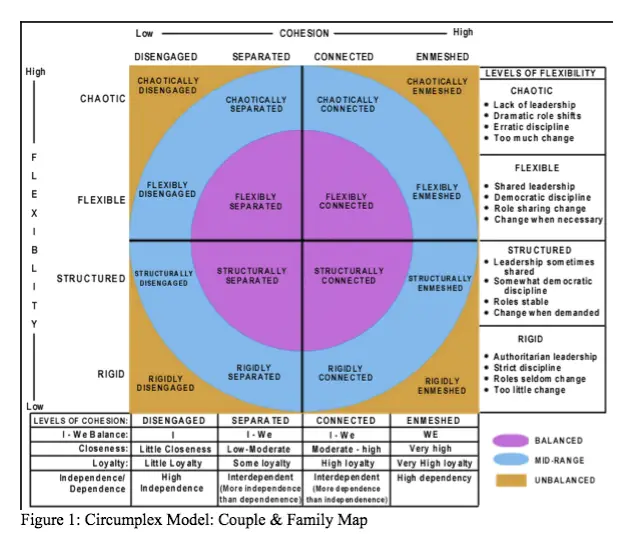
Let’s quickly see how these high levels we just mentioned are determined.
1. Cohesion (togetherness, closeness):
Disengaged (disconnected) relationships :
too little closeness
Balanced closeness:
optimal – balanced closeness
Enmeshed relationships:
too much closeness
2. Flexibility:
Rigidity:
too little flexibility
Balanced flexibility:
optimal – balanced flexibility
Chaos:
too much flexibility
The descriptions of Baumrind’s parenting styles, which emphasized responsiveness (support) and control, this model was able to scheme with 4 parenting styles.
But there was one quadrant in the model with no parenting style assigned. So conceptually the Circumplex model added the uninvolved style. It’s extremely high in flexibility – chaotic and extremely low in cohesion – disengaged.
And we should clear out one last thing that might be confusing, especially if you’ve never heard of these typologies. The main difference is the philosophy of the typology.
So:
- The optimal parenting style in Baumrind’s typology is a style with high levels of support and control (authoritative). This means the right combination of two high values is optimal (high control and high responsiveness).
- While in Olson’s model, high levels are determined as extreme. So for better family functioning, there’s a need for proper balance in each dimension (cohesion, flexibility, communication).
Finally, we can move on to explore what these 5 parenting styles look like.
And also on to what they produce as an outcome when it comes to kids’ emotional and social functioning. Let’s see!
Found this post helpful and want to take it with you to come back to it anytime! Get it as a print-friendly pdf with no interruptions on page. Plus you’ll be a direct supporter of this blog.

What the 5 parenting styles are: all you wanted to know
5,99 $ 4,99 $
#1 DEMOCRATIC OR BALANCED PARENTING STYLE
The Circumplex model’s Democratic (authoritative) parenting style is the balanced type among the other 4 types.
This model considers the other four styles tend to be more unbalanced. They score lower regarding balanced cohesion and balanced flexibility. And higher on one or more of the unbalanced scales this model consists of.
While Democratic (balanced) parenting has higher scores on balanced cohesion and balanced flexibility and lower scores on the unbalanced scales in the model.
So for the families, this means:
- The families that fall under the democratic spectrum, range from somewhat connected to very connected (for the cohesion dimension – togetherness).
- The democratic families vary from somewhat flexible to very flexible (when it comes to the flexibility dimension).
- The family is more functional as the levels of balanced cohesion and balanced flexibility are higher.
These parents establish clear rules and clear expectations and they discuss them with the child.
This means that these parents are open to negotiations with the child and the child’s participation in decision-making. As well as open to reconsidering their opinions or decisions.
This doesn’t mean they negotiate about the guidance of a child with the child. It simply means they support child autonomy as the child becomes more and more mature.
So they do show interest in a child’s perspective and acknowledge it. But they use reason and power to put their standards into effect.
And this is the key point why this is a representation of effective parenting. Because this way children always know where the boundaries are. What do they need to do or where they’re headed.
While at the same time they never feel powerless because they know their parents will always hear and see them.
This means that besides clear rules and expectations, the roles are clear too and they´re not intertwined.
They’re encouraging children’s independence with adequate monitoring. As well as consistent and fair with implementing disciplinary rules and expectations.
If you’re interested in hearing about 9 principles that promote child independence, then read my blog post that covers this. Here is the link to How To Help A Child Become More Independent – 9 Principles To Follow.
Note that Democratic or authoritative parenting is the most desirable style from the standpoint of the developmental needs of a child.
And if you’re curious about the most important benefits of this parenting style, I have a blog post for you. Read Benefits of Authoritative Parenting: for Parents and Children.
For more details about the style, you can continue reading in my post Authoritative Parenting: Characteristics And Effects That Make It The Best Style.
Now we move to our next parenting style, but before we do, let me mention a program you’ll find very useful for your parenting and relationship with your child.
#2 AUTHORITARIAN PARENTING STYLE
The authoritarian parenting style characterizes high levels of rigidity (inflexibility) and high levels of enmeshment (too much cohesion/closeness). So in this style, relationships can be described as highly rigid and too close.
This means an authoritarian type of parents sets quite rigid rules and expectations for children. And they enforce them very/overly strictly. And autonomy in children isn’t desirable. It isn’t welcome, nor is really accepted.
Also, this means that authoritarian parents show that they expect and demand (absolute) obedience as well as loyalty from their children.
That matches Baumrind’s description of the authoritarian style in which she states that this parent sees and values obedience as a virtue.
So this parent uses punitive and forceful methods to shape self-will when a child’s way of thinking or behaving clashes with what the parent considers to be appropriate.
She described a parent’s demand that children follow and trust the parent’s opinions and words dogmatically. And accept them with no space for any negotiation.
So child kept in their place, restricted in autonomy with order and traditional structure conserved.

The Circumplex model explains how these parents have high demands and expectations for the closeness of family members.
So when the authoritarian style intensifies, the model says the family moves towards the unbalanced style called rigidly enmeshed.
And this type of family system is particularly problematic for adolescents. Considering it highly restricts child freedom, who naturally rebel against it and fight it. And considering adolescents need more autonomy, this is undoubtedly logical.
In Diana Baumrind’s reviews children of (overly) authoritarian-style parents:
- can often behave in a conflicted-irritable manner
- tend to be unhappy
- are vulnerable to stress
- tend to be moody
- can act unfriendly.
If you want to focus on understanding more about this parenting style read my post: What Is Authoritarian parenting and who are authoritarian parents?.
#3 PERMISSIVE PARENTING STYLE
The permissive style by Circumplex Model indicated family system characterizes high chaos and high enmeshment.
Permissive parents let the child’s preferences prevail over their standards. So they rarely pressure the child to conform or attune to their standards.
They’re not confrontational enough or they avoid confronting. So the children lack boundaries because they can easily manipulate rules.
This parent tends to have a friendship with the child which then results in impulsive to aggressive behavior in the child.
The children become to be in charge of the family system rather than the parents, which means the roles get switched, intertwined, and dislocated.
As the permissive style grows even more extreme and far-off, the family moves to the “chaotic enmeshed” style.
That’s highly problematic for parenting to be effective. The reason for it is continual change and lack of stability. As well as coerced togetherness that is unhealthy for children. But for the family in general, too.
Baumrind stated that permissive parents tend to respond in a non-punitive and affirmative manner regarding the child’s desires and actions.
They leave the child to self-regulate rather than accepting the position of a figure that shapes behavior. And avoid using control.
She also observed that children of permissive-style parents exhibit impulsive-aggressive behavior in general. They’re often domineering, rebellious since they have problems accepting any authority, and low achievers.
Continue reading about this parenting style here: What is the Permissive (Laissez-faire iz) Parenting Styles and its Characteristics and Effects?.
If you found the information on the blog helpful & inspirational and you feel like giving back, you can do it by clicking the donate button after entering amount you’re comfortable with. I’ll use it to create and deliver more useful content and resources like this. Thanks for your precious contribution!
#4 REJECTING PARENTING STYLE
The Circumplex Model describes rejecting style as a style with high levels of rigidity and disengagement. So a parent nurtures high inflexibility when it comes to rules, discipline, and control. While he/she is disconnected from a child. So this means the family has very little emotional connection.
These parents don’t pay much attention to the child’s needs. And have expectations regarding how the child should behave occasionally.

As the rejecting style grows toward more extremity, the family moves to the “rigidly disengaged” style. Children are facing difficulty feeling cared for, while a parent demands they follow and behave according to many rules. They’re insecure about a parent’s affection and they question if they’re good enough.
As a logical outcome, these children usually face immaturity and psychological problems.
To learn more about this parenting style and understand if you fit this style, read my post that explores it it in more detail. Here it is: What Is The Rejecting Parenting Style And Are You a Rejecting Parent?.
And now, the last one.
#5 UNINVOLVED PARENTING STYLE
This parenting style is known as neglecting style. The uninvolved style of parenting in the Circumplex Model, with high levels of chaos and disengagement.
With uninvolved parenting, a child is ignored. And unless the child’s preferences interfere with the parent’s activities, those preferences will prevail.
As the uninvolved style becomes more extreme, it moves toward the “chaotic disengaged” pattern. This is so difficult for children considering they´re on their own without emotional support and a lack of consistent rules and expectations.
The uninvolved style often stays non-discussed in published research, but there´s a tendency in which the uninvolved style comes in combination with the rejecting style we described.
Children with uninvolved parents tend to be withdrawn, loners, and low achievers. You can continue reading about the uninvolved parenting here.
See the graphic representation of the 5 parenting styles in the image below. In accordance with their balance level.

And now let’s quickly see what behaviors come out of which parenting style.
HOW PARENTING STYLES AFFECT A CHILD’S BEHAVIOR AND DEVELOPMENT
A considerable amount of research on parenting has demonstrated more balanced families have children who are more emotionally healthy and fulfilled. And are more successful in school and in life.
Children who have experienced democratic-balanced parenting exhibit what Baumrind described as energetic-friendly behavior.
These children are very self-reliant and cheerful. They handle stress successfully and they orient towards achievement.
So this is seen as the optimal parenting style.
What’s important not to forget is the effect culture has on parenting styles. And how these parenting styles affect children then.
It can be different regarding the outcome of a certain parenting style. I mentioned parenting styles in different cultures later in the post.
Let’s see all 5 parenting styles and kids’ behavior as a result:
| PARENTING STYLE: CHILD’S BEHAVIOR OUTCOMES |
| Democratic (balanced): energetic friendly, self-reliant, and cheerful, achievement-oriented. |
| Authoritarian: less friendly/unfriendly, conflicted and irritable, unhappy, and lack stability/unstable. |
| Permissive: show impulsiveness and rebellion, low achieving. |
| Rejecting: facing immaturity and psychological issues. |
| Uninvolved: loneliness and withdrawn behavior, low achievement. |
But what’s also important is how you’re looking at all of this.
HOW TO UNDERSTAND PARENTING STYLES
First and most important of all, is that whatever your parenting style is, this doesn’t mean you’re a ”bad” person or unworthy.
We’ll talk about what affects our parenting style in a sec, but in general, what’s really important here is your willingness to improve (if there’s a need for it and you probably know if there is).
So whatever caused your parenting style that’s not working for your family and whatever happened before this moment, is less important than stepping up and taking responsibility for it from now on.
Now, all of this shouldn’t be understood only as a parent affecting the child. It’s circular as we mentioned when we talked about system theory.
So this means that a child´s behavior affects parenting style and parenting practices. So of course you as a parent adapt to your child as well.
This is because a child knows what to expect from a parent so it adapts to that. And a parent knows what to expect from a child too, over time.
Also, these results shouldn’t be looked at with an oversimplified perspective. Because as you probably know, there are children who managed even to thrive in the hardest circumstances.
It’s because they’re resilient, so certain things made them stronger. Of course, this doesn’t mean maltreatment is ever acceptable.
And also, many families consist of parents who have different parenting styles, so nothing is black and white here. Well, life isn’t anyways.
Yes, the Democratic parenting style is recommended, and you need to avoid rejecting and uninvolved styles, but there’s always a way and a CHANCE TO IMPROVE! Nothing is set in stone here! Try to remember that.
Also, when it comes to children’s behavior, there’s a tendency to pay attention to children who show more aggression. While those who are withdrawn can be seen as well-functioning children.
This should be reconsidered because a very withdrawn child might be experiencing many internal conflicts. Or even be suffering. So this is often a sign of insecurity and fear, and not of good behavior.
And the mischievous child can be seen as problematic, while that doesn’t have to be true one bit.
You shouldn’t demotivate mischievousness. Because an (overly) obedient child may experience many harms now and later in life. They can lack the resources and strength to stand up to someone who’s abusing them, for example.
The mischievous child is often highly intelligent, will question authority, ask questions, and strengthen individuality. This is what you want.
So reconsider thinking about an obedient child as a good child. And a mischievous one as a bad child.
More about Guidance you can find in my post Guidance From Parents – What Is It In Child Development?. I explored the importance of solid and balanced guidance you need to provide for your kids in that post in full detail.
FURTHER RESEARCH ON THE 5 PARENTING STYLES
Five parenting styles based on David Olson’s model described in 2016, were assessed on a sample of 667 mother-father couples. And you can see the full presentation of the findings here in this article. (You can find detailed descriptions of the different characteristics of couples that participated in the research if you’re interested to learn specifics.)
And here is a visual representation where you can see where is each parenting style positioned:
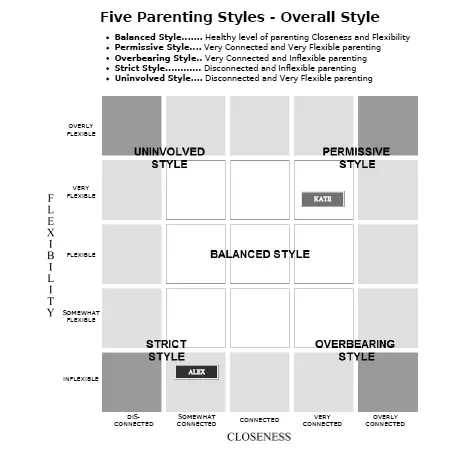
https://cdn2.hubspot.net
Now that you’re familiar with how the styles are determined, you’ll have a clear picture once you read each one’s core description.
- The balanced style remains the same, being moderate to high on both closeness and flexibility. These parents are warm and emotionally responsive. There’s a right amount of control where independence is welcome and a proper and consistent discipline system in place. And as you can see in the photo, the ”space of the balanced style” is the widest. That’s because of many different, but still positive ways parents can raise children and have a functional family.
- The uninvolved style is the same as the uninvolved style described before – with being very low on closeness (disengaged) and very high on flexibility (chaotic). So the parents lack emotional warmth and responsiveness. And with too much independence imposed on a child, because parents are not engaged in a child’s life enough. The rules are too loose and wavering, and not much is expected of a child.
- The permissive style is the same as well – with very high closeness and high flexibility (chaotic). The parents are overly protective, so a child feels smothered. But the control is not adequate because a parent looks more like a friend to a child so the discipline and expectations are not high enough.
- The strict style (a new term) is too low on closeness while not being flexible enough (inflexible). Where the parents are imposing very strict rules, harsh discipline, and restrict freedom. While being very disconnected emotionally from a child. So this is a very very difficult position for a child to be in, maybe the most difficult of all the other styles. This style fits the rejecting style we described before.
- The overbearing style (a new term) has too close and too connected parents and children while being very inflexible. So these parents are overly protective and go after every child’s needs. And are behaving like a friend to the child. But the discipline and control are very very high and strict. So the overbearing term is pretty adequately assigned here because that’s how this style feels to the children. This style fits the authoritarian style we described previously.

Understanding parenting styles and family relationships help you see what outcomes they can have on children. And most importantly, how your child feels because of your parenting style. And in what atmosphere do they live. So, use these descriptions to learn more about your situation.
If you found the information on the blog helpful & inspirational and you feel like giving back, you can do it by clicking the donate button after entering amount you’re comfortable with. I’ll use it to create and deliver more useful content and resources like this. Thanks for your precious contribution!
ARE THE PARENTING STYLES INHERITED AND WHAT INFLUENCES THEM?
You’ve probably heard about a widely spread concept about people’s parenting being a result of experience with their parents. While our childhood experience influences our parenting, we should be looking at this with a more open mind.
Moreover, recent research, showed that a parent’s genes play a great role in parenting too.
This recent research showed that genetic influences in parenting go from 23 % to 40 % of parental emotional warmth and responsiveness, control, and negativity towards their children.
What wasn’t clear is whether genes directly influence parenting or this happens indirectly. Through parent personality for instance.
So genes influence parenting, as well as the parent’s experience as a child, and the social environment, too. But also the child’s characteristics, which we talked about previously. And the child’s developmental phase, too.
As like we mentioned in the beginning, the family system is a system that’s exchanging information with its sub-systems and supra-systems constantly.
So this also means parenting is never detached from a society where it exists and grows, as well ad society’s developmental phase, of course. And its values, naturally.
And this also means culture influences parenting too. So different cultures can give different meanings to behaviors/practices. Let me give you some examples.
PARENTING STYLES IN DIFFERENT CULTURES
For instance, one culture can define strictness as a discipline (like training). Which then may result in children being achievers. Or one culture can see child labor (non-exploitative labor of course) as a way for a child to achieve certain independence. While others may be more sensitive about it.
Even though Baumrind’s findings hold true across ethnicity and social class, she discovered that authoritarian parenting performed very well with African-American low-income families she followed in one of her studies. Because it resulted in the most assertive and independent girls.
While this parenting style performed poorly with the rest of the participating children.
The reason for this isn’t determined, but it might be associated with ethnicity and culture, too.
Found this post helpful? You can take it with you and come back to it anytime! Get it as a print-friendly pdf with no interruptions on page. Plus you’ll be a direct supporter of this blog.

What the 5 parenting styles: are all you wanted to know
5,99 $ 4,99 $
WHEN DO PARENTING STYLES CLASH?
Parenting styles clash when they’re different and in conflict because then the parents have distinctive manners of demanding, providing structure, and responding to the need of the children.
For example, one parent has a permissive style and avoids providing structure and confronting the kids, yet expresses warmth, but is catering to all the kids’ needs. While the other has an uninvolved style where he neglects the kids, doesn’t provide structure so everything is chaotic, and doesn’t show care.
So these two styles clash when it comes to responsiveness – they’re opposite, they’re similar when it comes to structure and control (chaotic), and they’re different when it comes to demands and expectations because one style has occasional demands while the other has rare demands. All of this means that these parenting styles clash.
Different parenting styles aren’t something you as a parent should obsess about. First of all, yes, the (balanced) democratic style is optimal but there’s always space for change, and you can always take action to approach this parenting style. Also, it’s about perspective and about negotiations. Let me explain.
You probably have chosen your intimate partner because he or she fulfills you, or at least you thought so. And a part of this is because he is similar to you. But also it was important that are different from you regarding your personalities and character traits. Among other things, personality affects parenting style.
So this doesn’t need to change to something completely different now because, well, you probably wouldn’t like it (even if you think so now because we choose partners ”for a reason”), so that´s 1. And 2, you can always try to negotiate things and exchange arguments and opinions.

Both sides probably have their reason for behaving in a certain manner or doing something. So why not hear it out first?
Also, what if a child is benefiting from certain aspects of the other parent’s parenting style? Let’s say he/she is permissive so a child gets a high warmth and emotional responsiveness from him/her. While you’re maybe strict and focusing on the control while lacking emotional warmth. Children value emotional responsiveness very much.
If you want to learn more about responsiveness, check out my post about 4 Signs of Emotionally Responsive Parenting.
This means that maybe you both need to make certain changes. But it doesn’t mean you should antagonize the other parent if they’re different from you.
WHAT’S REALLY IMPORTANT IN PARENTING PRACTICES
What’s important here is detecting if you and your partner agree upon how you want to raise your child, who you want your kid to become as a person, health and protection aspects, education, etc.
I’ve noticed that different points of view or ways to do things in life are seen as different parenting styles, and in many of these examples, that’s not the case. Or it’s not always the case. This is more about coping and other strategies, habits, and previous experiences.
This means that maybe you and the other parent are ”heading to the same place” but you’re just choosing a different way or manner. For example, one of you thinks your kid should learn to do something through trial and error, and the other one is more focused on preventing certain errors. This way you could still be parents of a balanced parenting style for example.
BUT with the second one (prevention), you need to pay attention to whether you’re prone to over-protection. Because this is a bear service to your child. Your child needs to experience things, learn to cope with failure, and live a life in the end. It’s SO important that you let them.
And sending conflicting messages should be avoided, because then a child can manipulate the situation or simply be caught up in between, struggling with not knowing what to do.
And what´s important is to always think about our own demands or acts and analyze them first. Because it’s the easiest way to start. Like:
Are they coming from fear?
Are we overprotective? Are we high-maintenance or too demanding, do we have overly high expectations?
Or we’re too lenient and don’t set expectations that are high enough.
What is our favorite negotiating tactic?
What about power struggles, etc?
What I’m saying is that you should look at what you’re facing from different angles and perspectives. Then come to a conclusion and make decisions, you see as best at that given moment. Give yourself some space and time. You don’t need to have everything figured out all the time.
Give yourself permission not to have all the answers all the time.
And…
THINK ABOUT YOUR PARENTING FIRST
First of all, we can control and influence our behavior more easily. And secondly, all of this I just mentioned can be affecting our parenting style. So it´s never a bad thing to reconsider our own parenting practices.
See, what you’re doing at this moment or what you know about parenting isn’t set in stone.
Try to be reflective of it enough. As well as flexible enough to make changes if you need to. Or simply look at it as trying out different, new things and see how it goes.
Maybe the other parent’s idea isn’t as bad as you initially thought.
And when it comes to negotiations, it´s always better to try to be assertive with our demands toward the other parent. Where we try to avoid blaming.
This means you should rather focus on explaining:
- how a certain partner’s behavior affects us or/and makes us feel,
- or how it influences our authority regarding the kids,
- or what’s the outcome in kids’ behavior,
- what do we think would be a better way, etc.
This is a good way to go because this can lead to a solution that can be good for everyone.
And what happens if this exchange of arguments turns into a fight? Let’s explore.
SHOULD YOU BE ARGUING IN FRONT OF THE KIDS?
If the exchange of arguments leads to fighting, but then the fight arises to the level where it actually upsets the kids because it’s become disrespectful or ugly, then you’d better choose to continue it privately. Of course, we all want to avoid these ugly fights, but, you know, it can happen.
But if you can keep it under control (it’s respectful), you don’t need to keep the child isolated. This is because it teaches them to not bury conflicts and also that they can be resolved as well as how to resolve them.
I’m not really supportive of the approach where parents keep all the problems from kids. Because that’s like a fictional reality. They need to see real life.
And when it comes to effects on children, the most important is to send a clear message, not a conflicted one. So this means parents don’t need to do exactly the same things but have to send the same message. For example when it comes to activities with kids, or even implementing disciplinary measures.

So it’s important to talk with your partner if there is an undermining of one’s authority and set certain boundaries if you see a need for them.
Again, try to be assertive when you’re criticizing the other parent’s practices, because this will give better and faster results than attacking.
If you’re too upset, move away from resolving an issue at that moment, and postpone it to when you can manage to stay calmer. Of course, except if there’s an endangering of the kids, where you need to protect them.
But many times it’s more about our fears and interpretation of the situation. So let’s see some of them briefly.
YOU AND THE OTHER PARENT DON’T HAVE TO DO THE EXACT SAME THINGS
Remember that it’s enough if the child understands what the rules are. AND that you’re consistent with them. It doesn’t matter if one parent is conducting them more often than the other.
Look at your child to be sure. Observe if its behavior is functional. What about happiness, play, personal development, progress, and maturity?
And then think about your fears. What do you fear? How rational are your fears and whether they’re stopping your and the child’s progress? Talk with the other parent about this if you can, too.
And if you, for example, personally got sick of you being the one that has to put disciplinary measures in effect, try to support your partner to make switches with you. Because maybe this aspect is difficult for him/her.

This way you can understand their reasons better, and bond with your partner as well while doing it.
Maybe your partner had permissive parents. Or over – authoritarian so he/she doesn’t want the same your kids or is afraid of becoming their parents, etc.
Just keep an open mind, o.k? That´s always a good way to go.
Because every behavior has its internal or inner motivation. Even if it doesn’t look logical or it’s contradictory to what a person is declaring.
CAN PARENTING STYLES CHANGE?
Parenting style can change, as well as parenting practices, skills, and parenting competence. Whatever we have learned, we can unlearn and replace it with something else. Something more serving, more functional, or healthy for us.
Starting by acknowledging our parenting style, deciding to self-improve, then gradually changing our parenting practices, and improving our parenting skills and parenting capacity. (Learn more about parenting capacity here.)
This can then lead to changing the patterns, and then the parenting style is starting to transform. This affects the atmosphere, the interpersonal connections, and improves all the relationships in the end.
Therefore, here are some general quick tips that can help you with this.
Actionable tips:
– try to understand your parenting style using this post’s information
– talk to your children about different aspects of your parenting style or some practices, ask for honest feedback
– avoid being defensive or offensive on the feedback
– if you can, talk to your partner about it too
– be more open about negotiation
– be more open to change
– be more open to learning new parenting skills and practices or simply improving
– learn more about assertive communication
– consider family therapy if you´re experiencing family functioning problems
I hope this helps, let me know in the comments! Consider pinning this post for more people to find!
Latest Posts:
- Special Gifts to Let Someone Know You’re Thinking of Them (13)

- 100 Ways to Challenge Yourself (Without Stretching Yourself Too Thin)

- What To Do When Your Parent Struggles With Alcohol

- How To Navigate Moving to a New Home With Your Kids

- Prenups for Young Couples (A Modern Approach)

- What Happens When You Sign A Prenup (Relationship-Wise + Legally)

FINAL THOUGHTS ON 5 PARENTING STYLES
So we’ve made it this far together! Congrats to you and thanks for your attention!
We covered the discovery of parenting styles and the changes in their identification.
Even though you can see that the influence of the groundbreaking revelation of Diana Baumrind is still very present today.
Recognizing parenting styles help us understand the outcomes they can have on kids, and what we can do to change them. We also talked about parenting styles that clash and how to look at this. And finally whether or not they’re resistant to change.
I hope this post helped you understand your parenting style and its importance better. And if there’s anything that I didn’t cover but you think it’s important, feel free to let me know in the comments.
See you in my next post! Here is one:


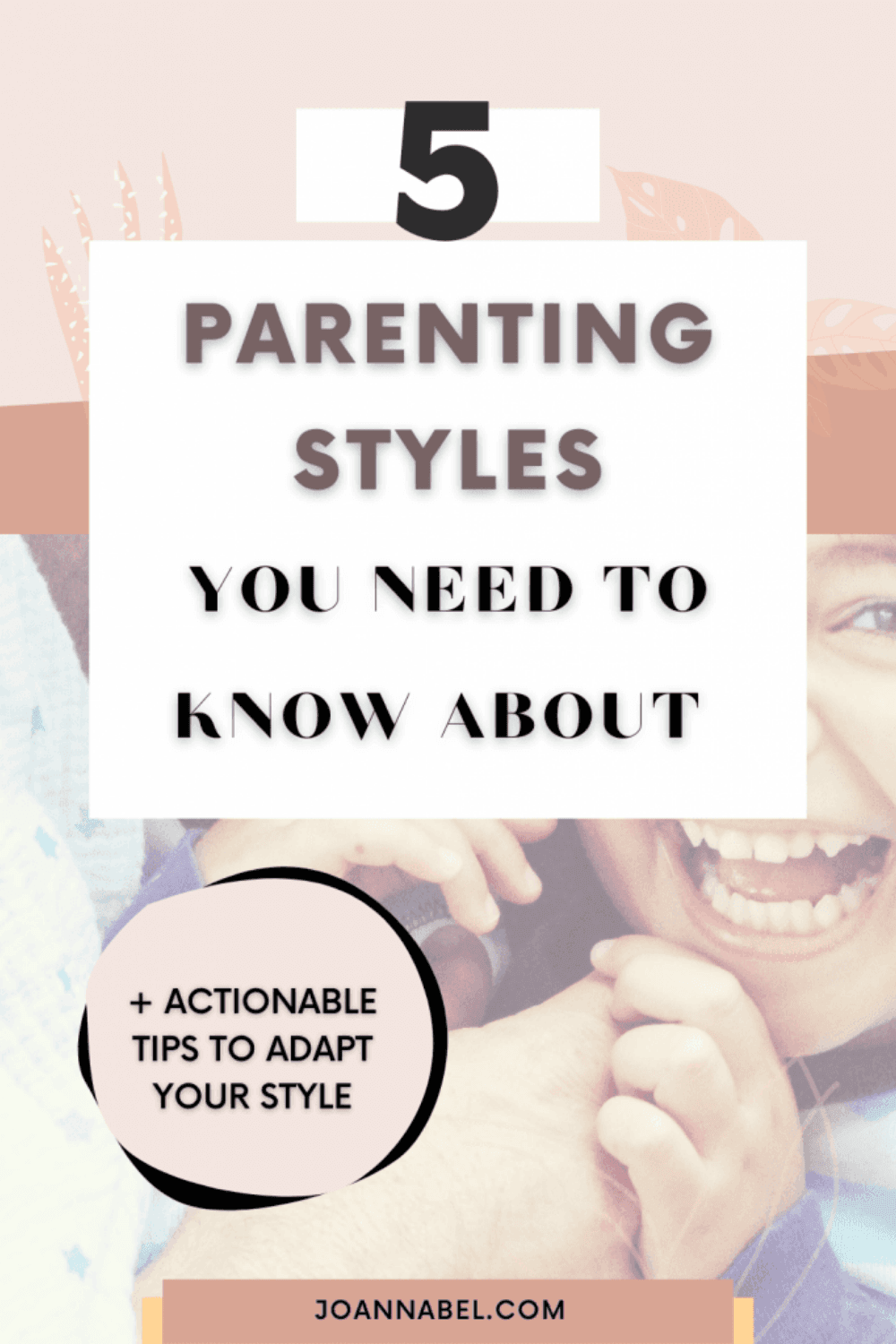
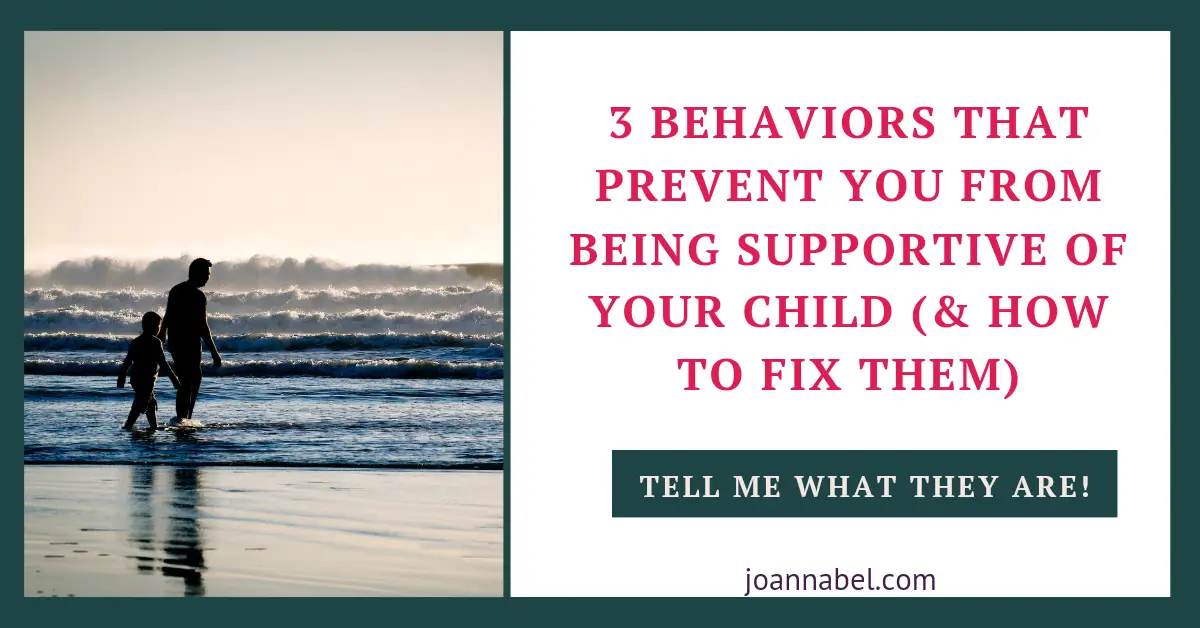





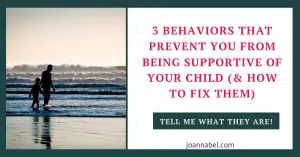

Leave a Reply